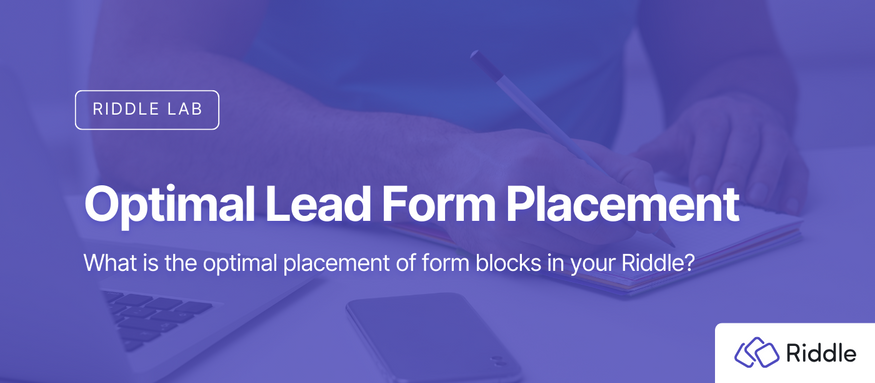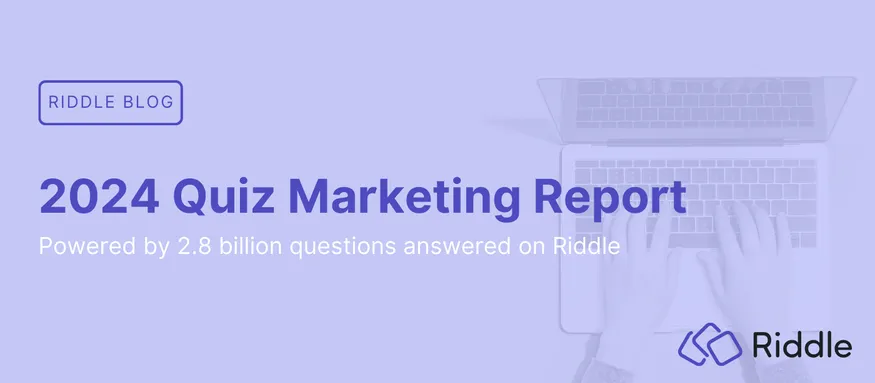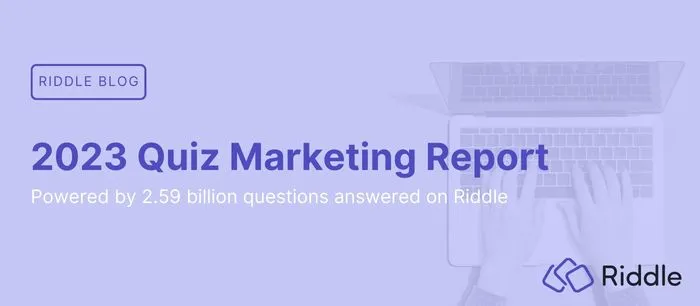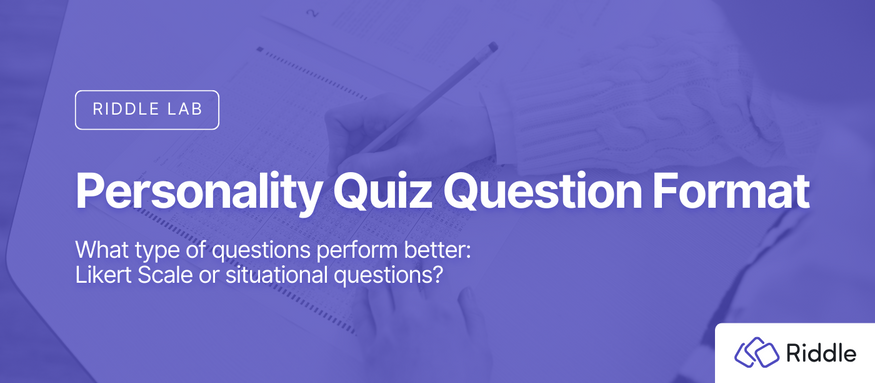Experiment: Form Placement
What is the optimal placement of form blocks in your Riddle?
Introduction
When gathering user information through quizzes, one crucial aspect to consider is the strategic placement of the form block. Determining where to position the form within your quiz can significantly impact user engagement and data quality.
This blog post will explore different placement options and guide you toward making informed decisions that enhance user experience and data acquisition.
Answering the following questions:
What is the ideal placement to ensure users willingly provide the desired information?
- Is it best to add a form at the beginning of a quiz?
- At the end of your quiz?
- Or should we split it up and gather information throughout after the user is already engaged?
Key considerations
While completion rates provide valuable insights, an effective approach to lead generation involves considering various factors to enhance user experience and maximize lead conversion.
To optimize your strategy, take into account the following considerations:
- User Engagement:
Form placement should seamlessly align with the user experience, avoiding disruptions or abrupt transitions. Integrating the form harmoniously into the quiz narrative ensures high levels of user engagement throughout the entire experience. - Incentives and Benefits:
Clear incentives encourage users to complete the quiz and willingly share their information. Personalized results, exclusive content, or discounts are powerful motivators that add value and increase participation rates. - Form Design:
Optimize the form’s design and length to minimize user friction.
A visually appealing and streamlined form with concise fields can significantly boost completion rates.
The Approach
To gather valuable answers to our questions, we tested three identical Riddles; the only difference was the placement of the form block. We made the form mandatory in all three variations to test quiz completion rates based on form submissions. Allowing users to skip the form would have led to wrong conclusions. However, we recommend making forms optional and only collecting data from users who are willingly signing up for your offers.
- Form Block at the Beginning: Making a Strong First Impression
Adding the form block at the beginning of the quiz has its advantages.
Placing it up front creates an immediate opportunity for users to engage with your content and provide their information willingly. This approach capitalizes on the initial excitement and curiosity of the participants, ensuring a higher completion rate for the form. - Form Block at the End: Capitalizing on User Investment
Positioning the form block at the end of the quiz can be a strategic move. By this stage, participants have invested their time and effort in completing the quiz. Placing the form here lets you capture valuable information from users who have demonstrated interest and commitment. It naturally continues their engagement, providing a seamless transition from the quiz to the form. - Form Block Split: Balancing Engagement and User Experience
Another approach is to split the form block and gather information incrementally throughout the quiz.
This method ensures a steady flow of user interaction while preventing information overload. By strategically placing form fields between quiz questions, you maintain user engagement and capture valuable data without overwhelming participants.
Results
After analyzing the statistics and quizzes’ performance, it is clear that the form placement strategy plays a crucial role in maximizing completion rates and lead generation.
Let’s examine the findings and highlight the strengths and challenges of each placement approach.
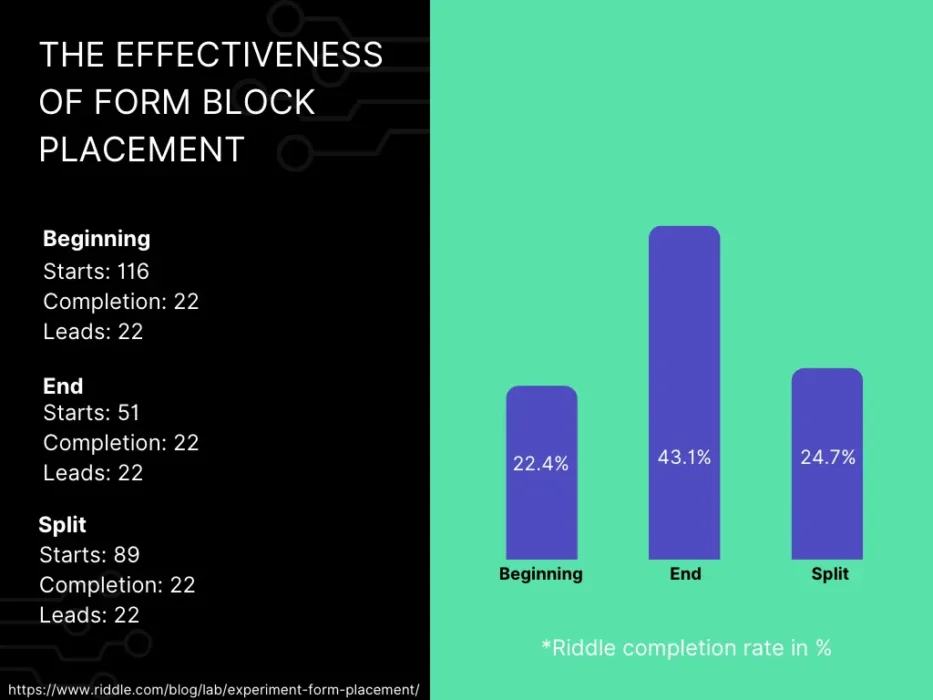
Summary
- Form Block at the Beginning:
Attained a completion rate of 22.4%.
This placement allows early lead capture. Targeting users who may not have completed the entire quiz but are willing to share their information upfront. The advantage lies in capturing leads regardless of completion and optimizing the conversion potential.
Please consider that some users might be hesitant to provide their details without fully engaging with the quiz content, which could result in lower completion rates. - Form Block at the End:
Outperformed the other quizzes with a completion rate of 43.1%.
Placing the form at the end ensured that users were fully invested in the quiz before being prompted for their contact information. The anticipation of receiving personalized results or recommendations motivated users to complete the entire quiz, leading to higher completion rates.
The challenge lies in maintaining user interest and engagement throughout the quiz - Form Block Split:
Achieved a completion rate of 24.7%.
This method’s advantage is the repeated exposure to the form throughout the quiz—the gentle reminders to provide contact information help maintain user engagement and contribute to lead generation. However, the form split approach might introduce the challenge of finding the right balance. Ensuring that the form placement doesn’t disrupt the quiz flow is essential.
Conclusion
In summary, the statistics of the Riddles highlight the importance of strategic form placement in optimizing completion rates and lead generation.
This will help you understand the importance and performance of different form placement approaches, which can help you make informed decisions to enhance your lead generation strategy.
Considering these findings, Quiz 2, with the form at the end, emerges as the top performer regarding completion rates. This placement strategy capitalizes on user motivation and commitment to the quiz, resulting in a higher likelihood of lead conversion.
Nonetheless, it is always important to recognize that the best form placement strategy may vary depending on the specific goals, target audience, and desired user experience.
